What is Scriptless Automated Testing?
by Kate Libbie | March 4, 2020 11:41 am
Fast, effective, reliable in results – Automation testing[1] has long captured the allegiance of both testing engineers and clients who want to test their software. But what if to go even further, and make automation simpler for testers? Scriptless Automated testing promises to conduct testing without the necessity to code. How much truth is in these claims? Let’s dive into scriptless testing and make a little investigation.
Scriptless Automated Testing definitions
Once upon a time, every testing procedure was manual[2]. But progress never stood still. Things have changed, and testers receive the opportunity to reduce the time for implementing routine tasks and cover the more substantial number of test cases. Was it magic? No, it wasn’t. Was it automated testing with writing scripts? Yes, certainly.
Automated testing quickly became a practical solution, although it never was the most straightforward path. Automation means coding, and coding is a troublesome endeavor[3].
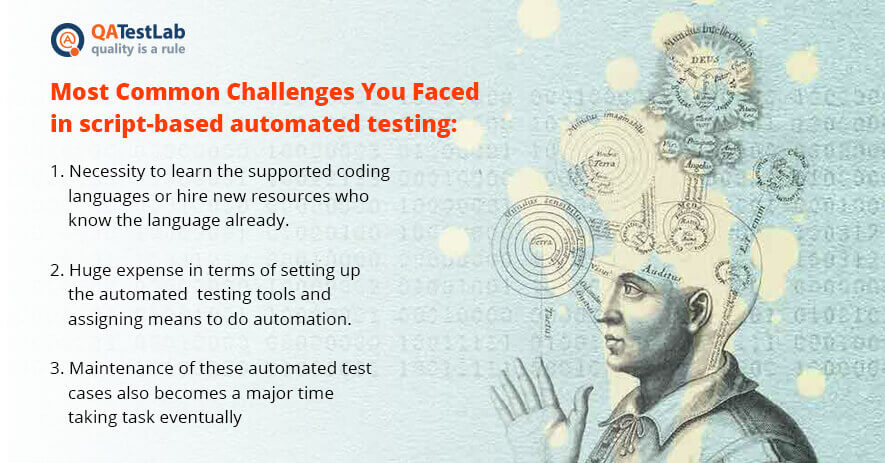
When traditional test automation[4] falls short with a bunch of new challenges, scriptless testing comes to the rescue. First off, it creates an ideal mixture of functional and technical expertise. How? Just use keyword abstractions as inputs to build test steps, adjust the process, choose the appropriate options for a specific problem, and voila – you can watch real enchantment.
Another advantage of such a codeless way is that you can detect bugs as soon as possible. Plus, it helps other business participants who do not have any knowledge of testing to understand this process, review test cases, and see a more clear picture of what the tester does. Overall, scriptless testing makes automation more straightforward, understandable, user-friendly and also allows the participation of industry users.
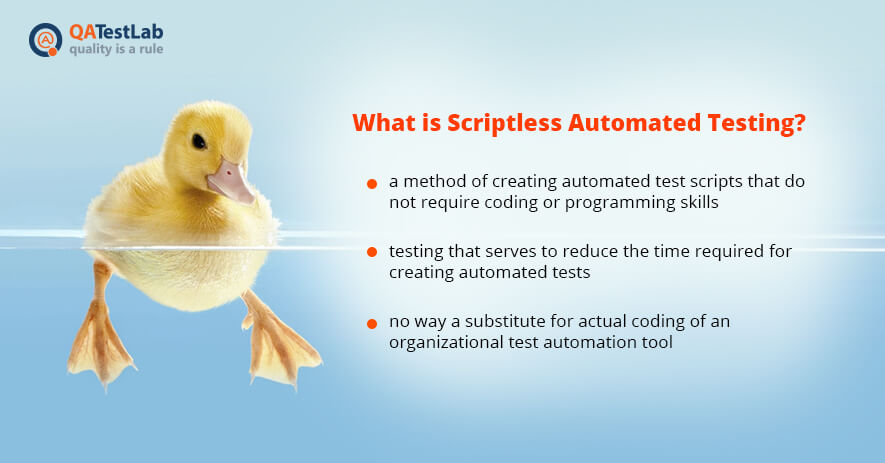
“No Scripts” or “Script free” method of creating automated test cases – it’s not a fantasy. But, it should be noted right from the start – it is not a cure for all diseases. It will serve to reduce the time required for creating automated tests, but it is no way a substitute for actual coding. Enlisted below are the main benefits and drawbacks of Scriptless Automated Testing:

Top Sctiptless Automated Testing Methods
Let’s look behind the curtain of creating scriptless testing. As a rule, for this type of testing, we use scriptless-based tools. But how do they work? There are several methods:
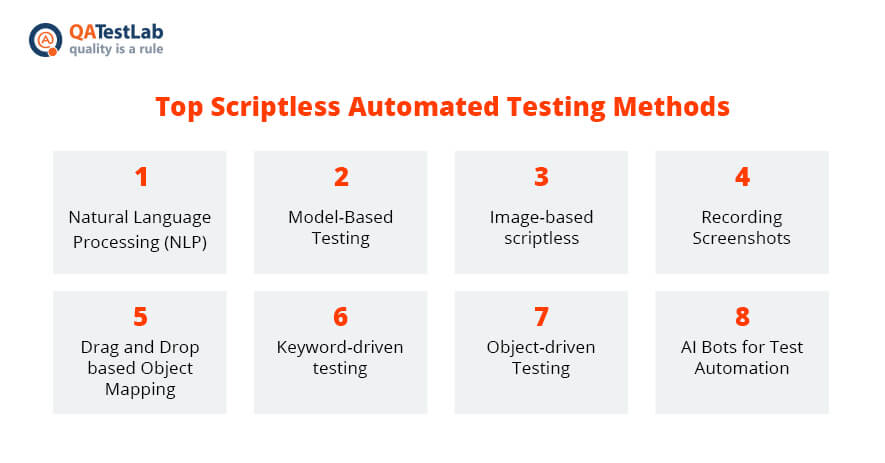
#1 NLP is cutting-edge technology and a part of Artificial Intelligence. It deals with all processes connected with languages and makes interactions with a machine more straightforward. NLP helps to tag coding snippets according to the needed operations.
#2 Model-Based Approach. The most vivid example of a Model-based testing methodology is TOSCA – a tool that automatically recognizes website objects. You select the needed objects and receive all the elements that may be appropriate to your specific case.
#3 Image-based automation. Using this method, you can remotely control the user interface. For automating all the necessary actions, it is enough to use English.
#4 Recording Screenshots. The tool records all the screens, and the picture doesn’t match the test case, it fails.
#5 Drag & Drop. The program simplifies and speeds up operations. You drag the desired item into the program – and get the necessary operation.
#6 Keyword-driven Approach. Another methodology to avoid coding which is similar to NLP. Select the needed procedure by dint of keywords and perform your testing comfortably and effectively.
#7 Object-driven software QA. Object-driven testing recognizes an object, and then you can observe test case creation.
#8 AI Bots. If to program bot well, it can also help you in implementing some routine tasks in automation.
Tools for Scriptless Automation
To the greatest extent, scriptless testing is just a toy, which is suitable for implementing simple tests. But this is not entirely true if you know how and what tools to use. What are the best scriptless-based testing tools? Here are our recommendations:
#1 ClicAutomate
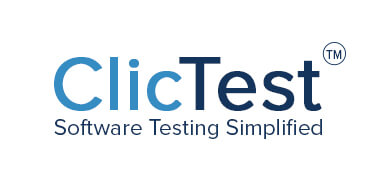
One of the opportunities to try scriptless testing in practice is this cloud-based tool supporting agile testing[5]. ClicAutomate promises low time for learning and fast test case creation without crafting a single line of code. It allows for handling the whole spectrum of differences in requirements or test cases.
#2 TestCraft
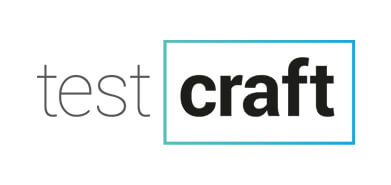
TestCraft is another one scriptless-based tool that will come in handy not only for automated testers but also for manual testing engineers. Based on AI, and it allows us to combine and leverage modules revealed by the community quickly.
#3 ACCELQ
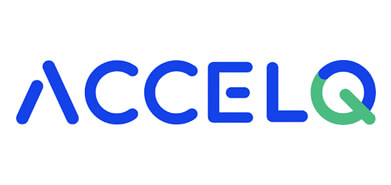
ACCELQ is AI-driven Codeless API that allows accelerating testing in a few clicks. It allows us to write Automated test case generation and data planning.
#4 Ranorex Studio

Powerful automation tool allowing to work with unique identifiers (container name, element name). Thanks to the “Drag-and-Drop” approach, it makes it possible to write tests with a minimum amount of “manual” code.
Conclusions
Although now there are lots of useful tools capable of escaping the need to code, calling them “scriptless” is as wrong as calling java a codeless programming language. Technically, scriptless testing tools are like a construction kit. You can record the user script in the built-in browser, extend the generated tests, test statements, configure the structure, and run the tests for execution. But in practice, there are a considerable number of drawbacks and ways to “shoot yourself in the foot.”
Do you want to learn more about testing and quality assurance processes? Feel free to follow us on Facebook [6]and Linkedin[7].
Learn more from QATestLab
Related Posts:
- Automation testing: https://qatestlab.com/services/test-automation/
- manual: https://blog.qatestlab.com/2019/07/25/manual-testing-skills/
- troublesome endeavor: https://blog.qatestlab.com/2019/07/16/automation-testing-challenges/
- traditional test automation: https://blog.qatestlab.com/2015/08/19/levels-testing-automation/
- agile testing: https://blog.qatestlab.com/2017/10/13/agile-projects-testing/
- Facebook : https://www.facebook.com/qatestlab
- Linkedin: https://www.linkedin.com/company/1576486
- Warning Signs: How to Identify Inefficient Test Automation in Your Project: https://blog.qatestlab.com/2024/10/02/warning-signs-in-test-automation/
- Automation, AI Testing, and Accessibility: Key Trends from VDS 2025: https://blog.qatestlab.com/2025/11/11/automation-ai-testing-and-accessibility-key-trends-from-vds-2025/
- Compliance Testing in iGaming: 5 Common Mistakes and How to Avoid Them : https://blog.qatestlab.com/2025/10/09/compliance-testing-in-igaming-5-common-and-how-to-avoid-them/
Source URL: https://blog.qatestlab.com/2020/03/04/scriptless-automated-testing/

